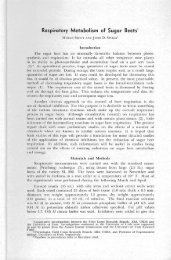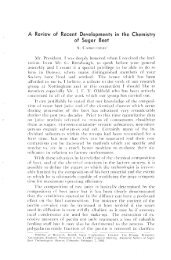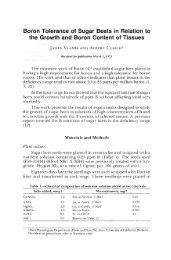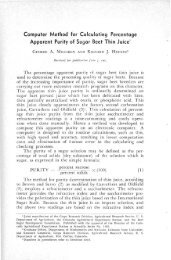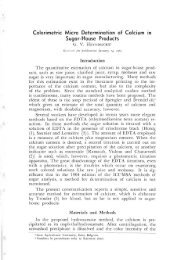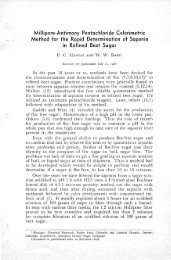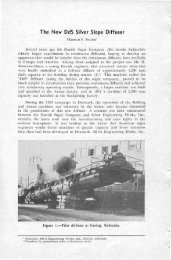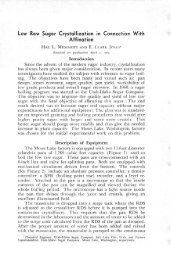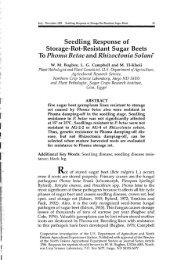Journal of Sugar Beet Research - Vol
Journal of Sugar Beet Research - Vol
Journal of Sugar Beet Research - Vol
You also want an ePaper? Increase the reach of your titles
YUMPU automatically turns print PDFs into web optimized ePapers that Google loves.
8 <strong>Journal</strong> <strong>of</strong> <strong>Sugar</strong> <strong>Beet</strong> <strong>Research</strong> <strong>Vol</strong>. 45 Nos. 1 & 2<br />
on 28 September at Perley while the 2002 plots were harvested on 24<br />
September and 17 September, respectively. At three <strong>of</strong> the four locations,<br />
only the center two rows were harvested to reduce the effects <strong>of</strong><br />
bordering plots, however, due to lower plant populations at the 2001<br />
Hillsboro location, all four rows were harvested for yield analysis.<br />
Each sugarbeet root was visually rated for Aphanomyces root rot and<br />
recorded on a 0 to 4 scale based on a scale developed by C. Windels, U.<br />
<strong>of</strong> Minnesota-Crookston (personal communication): 0 = Clean root; 1<br />
= Less than 10% <strong>of</strong> root surface is scurfy; root malformed; 2 = Greater<br />
than 10% but less than 25% <strong>of</strong> root surface is scurfy; root malformed;<br />
3 = Greater than 25% but less than 75% <strong>of</strong> root surface is scurfy; lower<br />
half <strong>of</strong> root rotted or malformed; 4 = Greater than 75% <strong>of</strong> root surface<br />
scurfy; and/or no root tip.<br />
Root samples were transported to the Minn-Dak Farmers<br />
Cooperative Lab (Wahpeton, ND) for yield and quality analysis within<br />
12 hours <strong>of</strong> harvest. Each individual sample (bag <strong>of</strong> roots) was rated for<br />
root yield, percent tare, sugar content, and impurity level (sugar loss to<br />
molasses). Statistical analysis for both locations and for both growing<br />
seasons was performed using Agricultural <strong>Research</strong> Manager (ARM<br />
6.1.12, Gylling Data Management, Inc., Brookings, SD). Assuming a<br />
randomized complete block design (Treatments: Biologicals, Blocks:<br />
Seed Chemicals), the data collected was analyzed for least significant<br />
differences (LSD; Fisher’s Exact Test) at the P = 0.05 level.<br />
ReSuLTS<br />
Controlled environment tests with seedlings.<br />
In agreement with previous reports on the efficacy <strong>of</strong> harpin protein,<br />
SA, and rib<strong>of</strong>lavin in the reduction <strong>of</strong> plant disease symptoms, foliar treatment<br />
<strong>of</strong> sugarbeet seedlings with these compounds reduced seedling root<br />
rot resulting from A. cochlioides challenge. Disease reduction was most<br />
consistent in treatments involving harpin and SA applications and this<br />
reduction was observed at several concentrations <strong>of</strong> A. cochlioides zoospores<br />
used for inoculation (Fig. 1). Treatment <strong>of</strong> seed with B. cepacia,<br />
P. fluorescens and hymexazol in growth chamber studies reduced seedling<br />
root rot as compared to those <strong>of</strong> the untreated check after inoculation with<br />
A. cochlioides zoospores, but in a variable manner. In these experiments,<br />
hymexazol clearly provided the greatest protection against seedling root rot<br />
(not shown). The addition <strong>of</strong> a foliar spray <strong>of</strong> harpin in conjunction with<br />
the seed treatments <strong>of</strong> hymexazol, B. cepacia, and P. fluorescens decreased<br />
the root rot rating in an additive manner, but the differences exhibited high<br />
variability and were not statistically significant.



